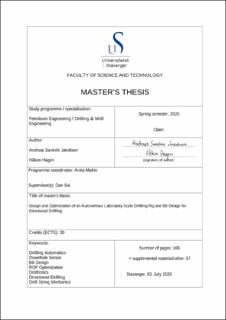| dc.contributor.advisor | Sui, Dan | |
| dc.contributor.author | Hagen, Håkon | |
| dc.contributor.author | Sandvik Jakobsen, Andreas | |
| dc.date.accessioned | 2020-10-27T13:27:48Z | |
| dc.date.available | 2020-10-27T13:27:48Z | |
| dc.date.issued | 2020-07-15 | |
| dc.identifier.uri | https://hdl.handle.net/11250/2685303 | |
| dc.description | Master's thesis in Petroleum Technology | en_US |
| dc.description.abstract | This report documents the work that has gone into the design and optimization of
a laboratory-scale drilling rig and bit design for the purpose of directional drilling
and to participate in the Drillbotics competition. Drillbotics is an international
competition organized by SPE's Drilling Systems Automation Technical Section
(DSATS) that challenges university teams to build an autonomous laboratory-scale
drilling rig. Each year a different challenge is introduced and autonomous directional
drilling, steering and downhole measurements are the main focus for this year's
competition.
A brand new Bottom Hole Assembly (BHA) was designed and manufactured at
the University of Stavanger to accommodate the improvements identi ed during the
2019 Drillbotics competition. One of the recognized challenges was the pneumatic
motor in the BHA breaking at the connection point. The addition of bushing,
bearings, a motor shaft and motor sleeve provided the pneumatic motor with the
necessary protection, and no motors broke during this year's testing.
A proprietary bit design has been 3D-printed at the University and designed with the
assistance from Lyng Drilling, a Schlumberger company. The UiS bit is optimized for
directional drilling and was made to enhance performance and ensure good borehole
quality. The results from the tests performed show great potential for the UiS bit,
and compared with the other drill bits it had the greatest horizontal displacement
built, reduced vibrations and excellent hole quality.
The implementation of a 9-axis Inertial Measurement Unit (IMU) on a custom
exible Printed Circuit Board (PCB) allowed the team to t the sensor closer to the
bit, providing more accurate data regarding the current bit position. The testing
of the downhole sensor was limited due to unforeseen incidents, however the sensor
has been assembled, calibrated and debugged. The results from the limited testing
showed great potential and the position of the IMU in the x-, y- and z-axis could
be measured. The code will be handed over to the team competing in the 2021
competition for further development.
Limited time for testing and a complicated BHA design resulted in countless hours
spent on making slight adjustments to overcome challenges and practicalities to
ensure a functional drilling assembly. The challenges, lessons learned and future
recommendations for the 2021 competition are thoroughly explained in the nal
chapter of the report.
The competition day for the 2020 competition should have been on June 24th in
Celle, Germany. Unfortunately, the competition was cancelled due to the global
pandemic and this report could not include the rig performance at the competition. | en_US |
| dc.language.iso | eng | en_US |
| dc.publisher | Universitetet i Stavanger | en_US |
| dc.relation.ispartofseries | Masteroppgave/UIS-TN-IEP/2020; | |
| dc.subject | petroleumsteknologi | en_US |
| dc.subject | petroleum engineering | en_US |
| dc.title | Design and Optimization of an Autonomous Laboratory-Scale Drilling Rig and Bit Design for Directional Drilling | en_US |
| dc.type | Master thesis | en_US |
| dc.subject.nsi | VDP::Teknologi: 500::Berg‑ og petroleumsfag: 510::Petroleumsteknologi: 512 | en_US |
